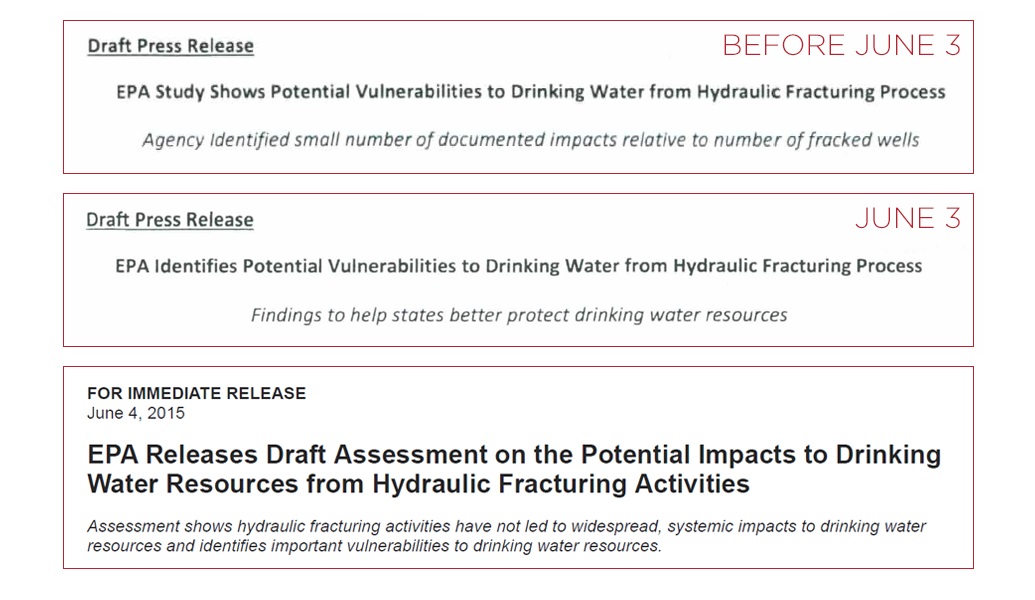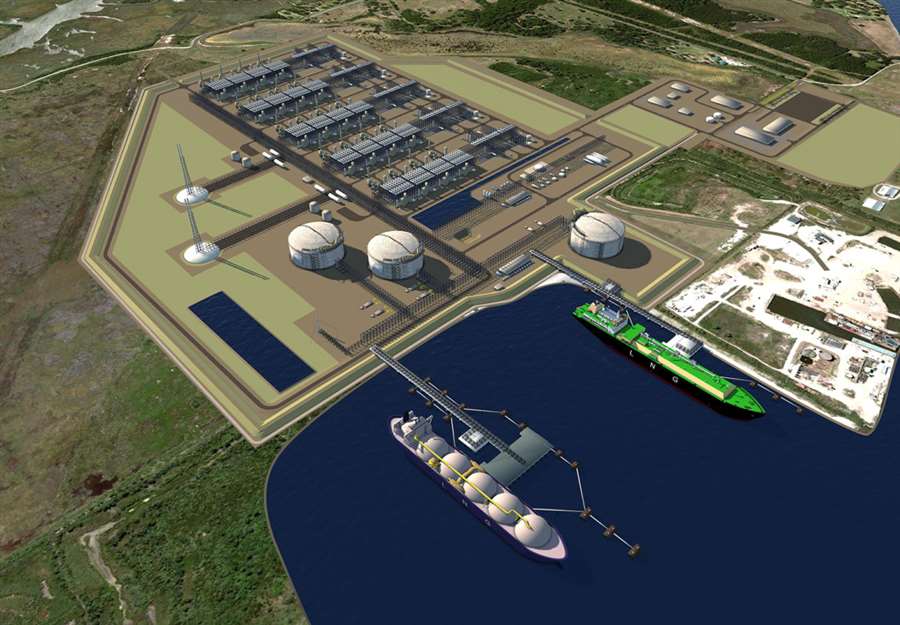Just before the U.S. Environmental Protection Agency released its high profile study on fracking, the agency planned to announce that the draft “study shows potential vulnerabilities to drinking water from hydraulic fracturing process.”
But that wasn’t the message the public heard the next day.
Instead, the EPA‘s press release highlighted a statement that the $29 million “[a]ssessment shows hydraulic fracturing activities have not led to widespread, systemic impacts to drinking water resources…”
That reassuring phrase was widely repeated in news headlines online, in print and on television, and touted by the drilling industry as evidence that despite spending millions of dollars, EPA had failed to turn up evidence proving that fracking was bad for people’s drinking water. For years, the oil and gas industry has insisted that there was not a single documented case where fracking polluted underground drinking water supplies – despite mounting evidence disproving that claim.
Now, a powerful new investigative report, based on internal EPA emails and documents obtained by Marketplace and American Public Media, show that the language about “widespread, systemic impacts” was added to the study itself shortly after White House-level officials were briefed on the EPA‘s research. And key changes to the EPA‘s public messaging about the study – which had already taken the agency’s scientists roughly five years to conduct – were made on the day before their preliminary findings were made public.
The emails, obtained through the Freedom of Information Act, were carefully vetted by Marketplace, which confirmed their authenticity with “three people with knowledge of the study” and conducted 19 separate interviews with individuals “familiar with the research” who labeled the EPA‘s denial of “widespread, systemic impacts” a “bizarre conclusion” and “irresponsible.”
Environmentalists expressed outrage at the newly uncovered last minute edits.
“We’ve suspected for months that the White House egregiously manipulated the headlines and summary findings of a draft study in order to obfuscate the details buried within – details confirming that fracking has caused numerous cases of water contamination,” said Food & Water Watch Executive Director Wenonah Hauter. “Today’s report confirms this political meddling.”
This August, that same inserted wording came under withering criticism from the expert panel charged with making sure that the EPA study’s science was sound.
Those experts concluded that the phrasing in the Executive Summary “appears inconsistent with the observations, data, and levels of uncertainty presented and discussed in the body of the draft Assessment Report,” – unusually strong language for a scientific review.
The newly released documents show that as of April 24, 2015, EPA‘s Executive Summary contained no mention of the phrase “widespread, systemic impacts.”
Instead, an internal draft of the Executive Summary reads, “Evidence from multiple sources indicates that hydraulic fracturing activities have contaminated drinking water resources in a variety of documented cases.” EPA‘s draft summary later added that “the number of documented impacts is quite low,” (though it is worth noting that the Summary that EPA made public explains that the number of documented cases “may be an underestimate as a result of several factors,” citing data gaps).
It was only after officials from the White House, along with top Interior Department and the Department of Energy officials, were briefed on the scientific conclusions that the controversial phrase found its way into the EPA‘s Executive Summary, Marketplace found.
Eight days after that briefing, a draft version cuts the sentence explaining that “multiple sources” showed fracking “contaminated drinking water resources”.
Instead, the Summary’s May 12, 2015 draft reads: “We did not find evidence of widespread, systemic impacts. The number of identified cases was small compared to the number of hydraulically fractured wells. This could reflect the rarity of effects on drinking water resources, but may also be due to other limiting factors.”
News coverage of the lengthy and technical study very often focused on the Executive Summary or looked to reactions from experts – which can produce a “he said, she said” narrative, with industry backers and environmentalists given time to air their take on how to interpret EPA‘s findings.
DeSmog previously took a close look at EPA‘s full report and itemized a litany of fracking-related problems that EPA reported, including hundreds or thousands of wastewater spills, a fundamental failure to track wastewater (which could prevent illegal dumping or other mishandling), multiple cases where fracking itself was the only available explanation for underground drinking water contamination, and instances where drillers failed to take the most basic of safety precautions.
For example, EPA noted, even though drillers talk about “best practices,” hundreds of wells per year in North Dakota were fracked without enough steel or cement casings – and skipping those casings makes the risk of water contamination skyrocket 1,000 fold.
In other cases, EPA said, drillers deliberately fracked into drinking water supplies, putting some people at risk in the short term, and more people at risk over the long term, if droughts force communities to drill water wells into those fracked supplies.
Those damning findings came even though the drilling industry was allowed to play a very close role in determining how EPA conducted its study and to limit the scope of the agency’s research.
“[Y]ou guys are part of the team here,” an EPA representative wrote to driller Chesapeake Energy as they together edited study planning documents in October 2013, a March 2015 DeSmog investigation based on over 3,000 pages of internal EPA documents found, “please write things in as you see fit.”
Marketplace did not report any changes to the body of EPA‘s 998 page study – just the Executive Summary and the press release.
Government studies about the oil and gas industry’s environmental impacts have been accused of being subject to political manipulation in the past. “It was like the science didn’t matter,” Carla Greathouse, author of a 1987 EPA study into the oil industry’s toxic wastes – which was used to justify an exception for drillers from hazardous waste handling laws even though researchers found many problems –told The New York Times in 2011. “The industry was going to get what it wanted, and we were not supposed to stand in the way.”
This time around, environmental groups are calling for the Obama administration to take conclusive action before leaving the White House.
“Enough is enough,” Ms. Hauter said. “It’s time for the administration to acknowledge its intervention in the crafting of the draft study, and issue a final version that clearly and conclusively highlights that fracking does indeed cause water contamination.”
Photo Credit: Timeline of Key Document Changes, via Marketplace
Subscribe to our newsletter
Stay up to date with DeSmog news and alerts







